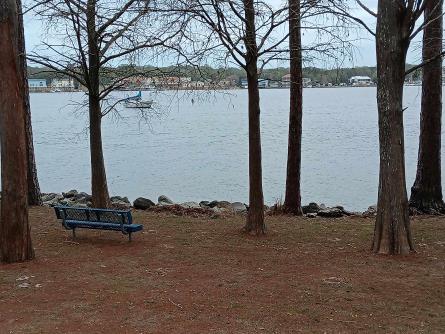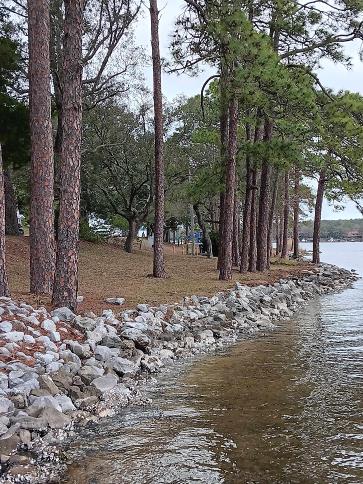|
Shipyard Point Park An Essay by James A Graves, Jr.
I decided to have lunch before a periodic medical appointment on a recent Friday afternoon in Niceville, Florida. As I finished eating I realized that I had misjudged my time and still had an hour to kill.
Niceville-Valpariso has grown exponentially since I worked at Eglin AFB during the 70’s and early 80’s. But since I go there so infrequently these days, I tend to live in the past and look for the places that I was familiar with those many years ago.
So I decided to cruise down John Simms Parkway toward the base, mostly to reminisce. Unfortunately, there’s not much left to reminisce about. Most of the places that I remember are gone now. My favorite restaurant was the A&W Root Beer stand. A few years ago I discovered that it was gone. It was the coolest place to have a meal. A full grown Live Oak tree stood in the middle of their screened-in patio where I always ate. Summer or winter, it didn’t matter, I loved the idea of simultaneously dining inside and outside, beneath a giant tree. Today, there’s no sign that it ever existed at all. I miss that place.
In the late 70’s, I was a guitarist & singer in a Rock band called Erik the Red. We leased the old Niceville Theater as a practice house. We called it The Rat Palace. Not only is it no longer there, I couldn’t even remember exactly where it originally stood.
Traveling on toward the base, the Addie R. Lewis School near the East Gate is still there. When it was being built in the early 70’s I worked at the construction site as an apprentice electrician. My employer insisted that electricians work on energized circuits, even when it was unnecessary. Because of that, in two separate incidents, two of the guys that I worked with were almost electrocuted. One, was nearly blinded. I was forced to work on energized circuits unnecessarily as well, on multiple job sites on the base. Today, OSHA would require a work stoppage, and would levy huge fines for safety violations of that magnitude. Some of my memories of working at Eglin are not that pleasant.
I fondly remembered a little park on Boggy Bayou along North Bay Shore Drive and wanted to see if it was still there, so I turned around and headed back toward Niceville. At lunchtime in the late 70’s, when I needed to get away from the noise of work, and the bustle of the noon rush, I would escape to the park to eat my lunch. It was always peaceful. The water quietly lapped the narrow white-sand beach. In some spots, the well-manicured lawn touched the water’s edge.
It was a tiny park, barely 150 yards long and maybe a hundred feet wide at the widest point. At midday during the week, there was rarely anyone there but me, so it seemed as if, just for a short moment, the park was my special place to escape the noise of life. Oddly, even though I was only a few miles from Eglin’s noisy runways, I rarely heard any jets. Perhaps they’re having lunch, too, I thought.
I didn’t remember the name of the park, or exactly where it was, but I remembered the turn off from John Simms Parkway onto North Bay Shore Drive. Just a short excursion along the winding drive that follows the bayou brought me to the park. This time I paid enough attention to note the name—Shipyard Point Park.
And it was just as I remembered. I was amazed. Nothing appeared to have changed. Almost 46 years had passed since I last saw my little park, yet it seemed as if time had stopped in 1978, holding this special place frozen in time. Even the bench where I sat to eat lunch was still there, silently waiting to provide the perfect spot to view the peaceful bayou.
The only change that I could see were large stones that had been obviously placed along the shore to prevent erosion from an angry surf created by storms and passing yachts. And no doubt this little park, perched out on a point in Boggy Bayou, has endured many storms during the past decades since I was last here. Damaged and repaired. Damaged and repaired. Storm after storm. Yet, with a lot of effort no doubt from caring workers, the little park has managed to maintain its peaceful, enduring beauty for all these many years.
I sat on the bench for a while and soaked up some of that perfect solitude. There was a cool, refreshing winter breeze blowing across the bayou, making me glad that I decided to wear a long sleeve shirt. I walked along the shore and admired the wisdom of the ones who placed the erosion-preventing stones there. The narrow, white-sand beach, manicured grass-lined shore, and long-surviving trees are well protected from waves and storm-surge for the foreseeable future.
A young couple and their three kids walked by, heading to the playground and swings. I don’t recall seeing a playground years ago, but then, I didn’t see the park sign either. Still, I assume the playground is also an addition. But it’s a perfect choice. I can’t think of a better place for kids to play.
I finally remembered to take pictures – something I should have done then to compare with now.
And then, sadly, it was again time to go. Reluctant to leave that healing peace and solitude behind, my desire was always to linger just a bit longer.
Life along coastlines and flowing rivers is fleeting and fragile. People flock to coasts and riverbanks, searching for the “salt life”, or Riverlife, but few stop to consider the ever-changing geography that define those places. We need only to review how many ancient, formerly-coastal cities that must now be visited using scuba gear, or view historical maps that show where riverbank cities once stood that are now part of the river channel, to realize that making coastlines or riverbanks home is a temporary pleasure at best.
The earth doesn’t care that we humans live on it. Geologically speaking we’ve only been here a short time, and, like an infestation of fleas on a grizzly bear, we exert very little effect on earth’s wellbeing. We are God’s children. And long after He has called us home, Mother Earth will spin on as if we never existed.
Eventually, as the sun depletes its supply of hydrogen fuel that powers its magnificent fusion furnace, it will begin to expand in the throes and gasps of the end of life. And just as the Bible’s 2 Peter predicts, the Earth will be incinerated. Finally, having consumed all of the planets that it once provided heat and light, Sol will collapse into a celestial white dwarf. It will maintain the density of its former grand self, but slowly cool to eventually become a very dense, earth-size black rock floating aimlessly in the Milky Way galaxy.
Knowing how much things change, and how things will eventually end, I find great comfort and hope in one tiny, enduring coastal park that is resisting the effects of time with every fiber of its tenacious heart. ©2024 J. Graves, Jr. Back to Main Page Pictures ˅˅˅
|

